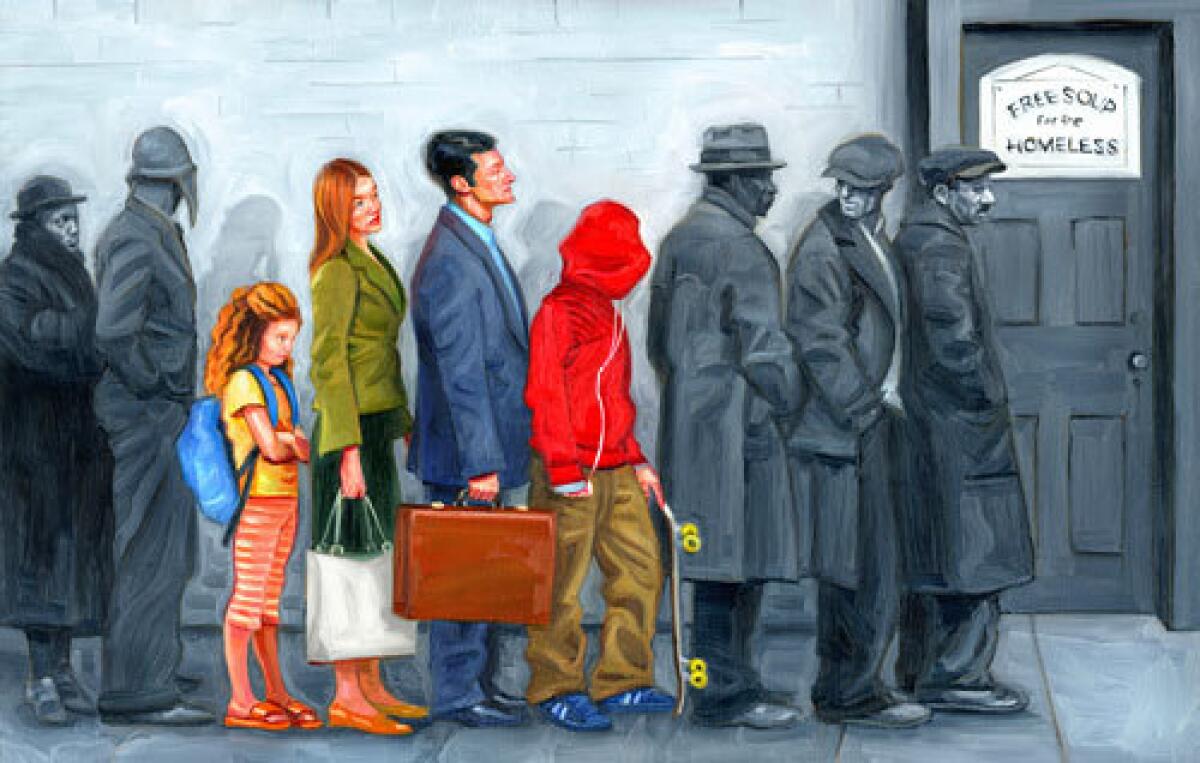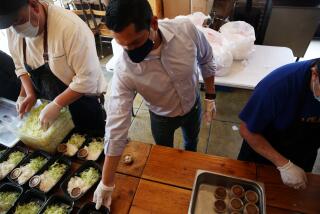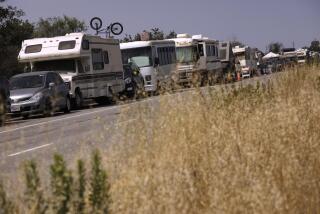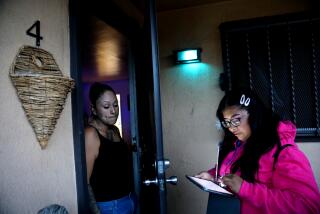Suddenly on the skids

If you’re eating three meals today and have a roof over your head, you’ve probably never heard of the 211 service.
It’s like 411 or 911, except you use it when you’re in such financial distress that you don’t have enough money for food or perhaps even for a place to live.
In this economic climate, those conditions can arise alarmingly quickly.
“We have households that six months ago made $70,000, $80,000,” said Michael Flood, chief executive of the Los Angeles Regional Food Bank, “and then the bottom falls out.”
This is a consumer guide for the nouveaux poor, individuals and families who suddenly find themselves in financial peril. A good place to start is the 211 referral services, available in Los Angeles, Orange, Riverside, San Bernardino and Ventura counties.
The L.A. version is available 24/7, including holidays.
“All day long we have people saying to us, ‘I never thought this could happen to me,’ ” said 211 staffer Irene Aceves while taking calls on a recent afternoon at the L.A. operation’s headquarters, a former bank in San Gabriel.
Denial is common. Michelle Vu took a call from a woman in Hollywood who had lost her job, leading to the eventual loss of her home. For the last four nights the woman had slept in her car.
“I told her about shelters where I could possibly find a place for her,” Vu said. “She said she didn’t want that because shelters are for people who are homeless.”
For someone who needs help, it’s important to make the call promptly. Competition for services is getting fierce.
Maribel Marin, executive director of L.A. County 211, said the number of calls the service receives each month has jumped from about 30,000 last year to just over 50,000 now. With more people in need, food banks are coming up short, housing organizations have years-long waiting lists and the wait for medical services grows longer. Even the annual Christmas toy charities are hurting.
“More average people, not on the street, are calling to get Christmas presents for the kids and a Christmas meal,” said Maggie Hutchinson, who has taken calls for 21 years at 211 L.A. County and its predecessor that used an 800 number.
It’s not all bad news at 211. There are victories.
One recent evening, Miguel Serrano called numerous shelters until he found one that would provide a voucher -- rare for that late in the day -- for a woman and her two children to stay the night. As Serrano gave the woman the details, he quietly pumped his fist in victory.
Serrano had stayed past his quitting time to complete the call. But as he packed up he was beaming.
“A call like that can make your day,” he said.
This is merely an introduction to navigating the system.
“If you’ve been a low-income mother of five, you know all the agencies and the nonprofits where you can get help,” said John Kim, director of the Healthy City project that is working on a consumer-friendly online guide to these resources.
“But if you just lost your home and your job, you’re new to this world. You are looking around, saying, ‘Where do I turn?’ ”
Food
One of the most direct, nonbureaucratic paths to getting help is at food pantries that provide the needy with free groceries. The Los Angeles Regional Food Bank supplies more than 400 of these pantries, and there are others that get supplies from other sources.
Many of these operations are located at churches, synagogues and other faith-based facilities.
If you have access to a computer -- and most libraries have terminals that you can use free -- you can find a pantry near you by going to the food bank’s website ( www.Lafoodbank.org) and clicking on “Pantry Locator.” Fill in a ZIP Code or city name to get a list of pantries in that area and their schedule of grocery distribution.
The locater also can be used to identify agencies that serve meals to people in need.
If you don’t have access to a computer, call 211. The staff there has access to the list.
Each of the pantries has its own rules. Some allow anyone to line up; others may have geographical restrictions or limit the number of times an individual can participate.
The need is rising sharply, and donations aren’t keeping up.
“Our pantry demand is up 41% over last year,” Flood said, but the food bank has been able to increase its supply by only 33%.
Pantries affected by the shortfall are cutting back on the amount of food they give each person, he said, or by reducing the number of people they serve.
For longer-term help, people can apply to the county for food stamps, which can be used to purchase groceries at supermarkets and other stores that accept them. But there are a number of qualifications that must be met. For example, the maximum income allowed for a family of four in the program is $2,297 a month.
Housing
This is one of the toughest problems because of the scarcity of supply.
For short-term emergencies, free shelters sometimes have room, but vouchers are often good for just one night. And many shelters are set up for individuals, not families.
For longer-term subsidized housing, there are two main programs, generally known as Section 8 and public housing.
Section 8, funded by the federal government, puts people in low-cost housing. In most cases, the client household is required to contribute 30% of its income toward the rent. The rest is picked up by the program.
The public housing program puts clients in apartments owned by the Housing Authority of the City of Los Angeles, with rents subsidized on a sliding, income-based scale.
The two programs are similar in an important way: It can often take years for a qualified family or individual to actually get a place.
The waiting list for Section 8 housing is currently closed, but the housing authority, which administers the program, plans to reopen it early in 2009.
Section 8 Director Lourdes Castro-Ramirez says that in 2009 the program should be able to place 3,000 to 4,000 families. But that’s just a fraction of the expected number of applicants.
“We are estimating that about 300,000 will apply,” Castro-Ramirez said.
The ones that stay on the list might get placed in five to 10 years, she said.
It’s not much better at the public housing program. “There are about 17,000 on the waiting list,” said Sanford Riggs, director of housing services. “We have about a 3% vacancy rate per year.”
It generally takes two or three years to get into public housing.
So where does a family with more immediate need go?
“The speculation is that they will either move in with family or move into a unit with others that becomes overcrowded,” Castro-Ramirez said. “Or they may end up on the streets.”
Healthcare
The most generous safety net in healthcare is provided by the state Medi-Cal and federal Medicare programs.
But if you don’t qualify because of age or income and don’t have medical insurance, you’ll probably have to rely on the county-subsidized healthcare system.
Although highly qualified and dedicated people work in that system, you’ll be entering a world of delays and bureaucracy. If your health problem is an emergency requiring an ambulance, by law you’re supposed to be taken to the nearest emergency room that can accept a patient.
“The hospital has to do a medical screening examination, and they have to stabilize you,” said Carol Meyer, interim chief network officer for the Los Angeles County Department of Health Services.
In many cases, Meyer said, you’ll be treated and sent on your way. If it’s a private hospital, you’ll probably get a bill later that you can’t afford to pay. But most hospitals have programs to reduce or cancel bills based on financial hardship.
If you need more care and can be stabilized for transport, the private hospital has the right to send you to a public hospital, such as Los Angeles County-USC Medical Center.
Nonambulance visits to a public hospital emergency room can involve a long wait. “It can range from a couple of hours to 16, 17 or longer,” Meyer said.
Nonemergency primary care is available at county-run clinics. In Los Angeles County, there are six of them. But patients are also accepted at about 100 other clinics that have contracts with the county.
For a list of clinics accepting new patients, go to the L.A. County Health Department website and click on “Clinics.”
Getting an appointment can be a challenge, especially for specialty care that the insured might take for granted.
Eye exams, for example, can take weeks, Meyer said.
Preventive care, such as check-ups, can be difficult if not impossible to obtain, even though such care can catch minor conditions before they become serious and much more expensive to treat.
“The evidence for that is well documented,” Meyer said. “But the demand to treat patients who have specific conditions is so high that it uses most of our resources.”
--
david.colker@latimes.com







